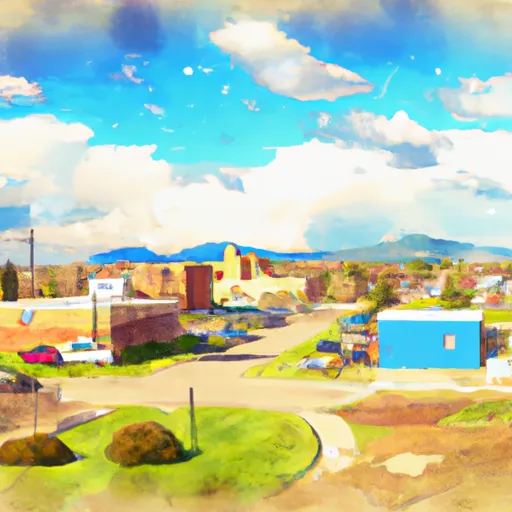-
 Snoflo Premium
Snoflo Premium
Get unlimited access to all our content
With no Ad interruptions! - Start Your Free Trial Login with existing account
Moore
Eden Index
Climate
7.2
•
Recreation
0.3
•
Community
2.4
•
Safeguard
3.6/10

Moore, Montana is a small town located in the heart of the state, surrounded by vast plains and rolling hills. The climate in Moore can be characterized as a continental climate with cold, snowy winters and warm, dry summers. Average temperatures range from around 20°F (-6.7°C) in winter to 85°F (29.4°C) in summer, making it an excellent destination for those who enjoy experiencing all four seasons.
Hydrologically, Moore is situated near several bodies of water, including the Missouri River to the north and the Judith River to the south. These rivers not only provide scenic beauty but also offer various opportunities for water-based activities such as fishing, boating, and kayaking. Additionally, the surrounding area is home to numerous lakes and reservoirs, allowing visitors to enjoy recreational activities like swimming and water skiing.
For outdoor enthusiasts, Moore offers an array of recreational opportunities. The vast open landscapes make it a prime location for hiking, camping, and wildlife viewing. The nearby Little Belt Mountains provide opportunities for mountain biking and horseback riding, while the vast plains are perfect for hunting and birdwatching. Overall, Moore, Montana offers a diverse range of outdoor activities for nature lovers and adventurers alike.
What is the Eden Index?
The Snoflo Eden Index serves as a comprehensive rating system for regions, evaluating their desirability through a holistic assessment of climate health, outdoor recreation opportunities, and natural disaster risk, acknowledging the profound impact of these factors on livability and well-being.
Climate Health Indicator (CHI): 7.2
Moore receives approximately
418mm of rain per year,
with humidity levels near 69%
and air temperatures averaging around
7°C.
Moore has a plant hardyness factor of
4, meaning
plants and agriculture in this region thrive during a short period during spring and early summer. Most
plants will die off during the colder winter months.
By considering the ideal temperature range, reliable water supplies, clean air, and stable seasonal rain or snowpacks, the Climate Health Indicator (CHI) underscores the significance of a healthy climate as the foundation for quality living.
A healthy climate is paramount for ensuring a high quality of life and livability in a region, fostering both physical well-being and environmental harmony. This can be characterized by ideal temperatures, reliable access to water supplies, clean air, and consistent seasonal rain or snowpacks.
Weather Forecast
Streamflow Conditions
Fort Peck Lake
Area Rivers
Fort Peck Lake
Snowpack Depths
Fort Peck Lake
Reservoir Storage Capacity
Fort Peck Lake
Groundwater Levels
Recreational Opportunity Index (ROI): 0.3
The Recreational Opportunity Index (ROI) recognizes the value of outdoor recreational options, such as parks, hiking trails, camping sites, and fishing spots, while acknowledging that climate plays a pivotal role in ensuring the comfort and consistency of these experiences.
Access to outdoor recreational opportunities, encompassing activities such as parks, hiking, camping, and fishing, is crucial for overall well-being, and the climate plays a pivotal role in enabling and enhancing these experiences, ensuring that individuals can engage in nature-based activities comfortably and consistently.
Camping Areas
| Campground | Campsites | Reservations | Toilets | Showers | Elevation |
|---|---|---|---|---|---|
| Crystal Lake | 28 | 6,051 ft | |||
| Chief Joseph City Park | None | 4,170 ft |
Nearby Fishing
Catastrophe Safeguard Index (CSI):
The Catastrophe Safeguard Index (CSI) recognizes that natural disaster risk, encompassing floods, fires, hurricanes, and tornadoes, can drastically affect safety and the overall appeal of an area.
The level of natural disaster risk in a region significantly affects safety and the overall livability, with climate change amplifying these risks by potentially increasing the frequency and intensity of events like floods, fires, hurricanes, and tornadoes, thereby posing substantial challenges to community resilience and well-being.
Community Resilience Indicator (CRI): 2.4
The Community Resilience Indicator (CRI) recognizes that education, healthcare, and socioeconomics are crucial to the well-being of a region. The CRI acknowledges the profound impact of these elements on residents' overall quality of life. By evaluating educational resources, healthcare accessibility, and economic inclusivity, the index captures the essential aspects that contribute to a thriving community, fostering resident satisfaction, equity, and social cohesion.

